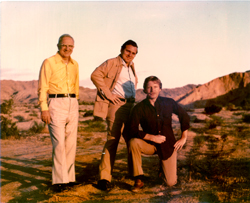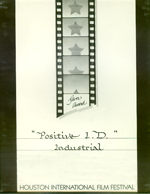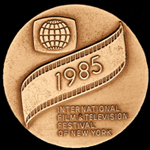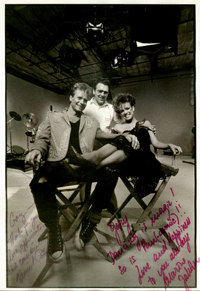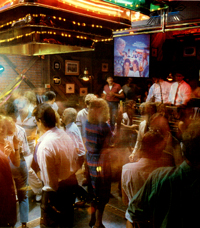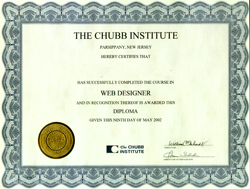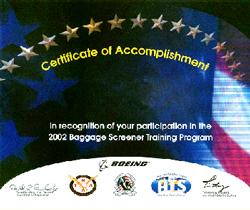|
Professional Background Rather then provide a few boring line items that would look like someone's resume, allow me to give you an overview of a life of full-time working, which began at age 23 and ended 39-years later, my retiring at 62. I think this kind of format will help others who are struggling, showing them that they are not alone in this difficult world. So let's get down to business. After taking out loans, washing dishes, cleaning toilets, and working part-time, I was able to finish college with a degree in art education. My first employment was as a high school teacher for $4,300 for nine months work, including selling hot dogs at night during the football season while living in a mobile home. I was able to later feed my interest in consumer electronics five years later by enrolling in a two-year home-study course in the early 1970's. The course would provide me with raw training on the repair of home audio and television products. At the time vacuum tubes were quickly being replaced by circuit boards filled with transistors and large scale integrated (LSI) chips. This new world was being called "integrated circuits" (IC's), which would prove to be better, faster, cheaper, more reliable, would use far less power, run cooler, and would allow for smaller and lighter-weight cabinets. The course required the actual construction of several electronic test kits including a 25" Heath color television from the bottom up. That's where I learned the art of converging a picture tube. The choice of a home-study course actually helped lead me out of public education and into a position two years later of audio/video technician at the local high school, then soon after into the business world. While teaching, I earned extra income with many part-time jobs, one selling Magnavox Star Televisions along with their professional MX Series of high-end audio products. Magnavox Star System was one of the first televisions to have a 120 cable-channel television tuner. Ironically, I discovered by accident that the newly designed chip on the tuner board, which automatically sensed the many incoming channel frequencies for the Magnavox Star System, had actually been built by Matsushita Electric of Japan, its own television sets sold in America under the trade name Panasonic, with National Panasonic being their overseas trademark. Selling on the sales floor allowed me to learn the basics of how to sell by identifying the needs of the customer. It was an art, with the information becoming invaluable to me in later years. Among the different cabinet styles of color televisions and stereo systems, I also sold the first video game in history that was also manufactured by Magnavox, called "Pong." It was a simple electronic concept following the rules of the game "Ping-Pong," the unit played with two controllers on the customer's home television set. The game used a wide vertical line on the television screen as a net, which never moved from the center of the screen. Kids or others who played the game sat in front of the television for hours . . . even days at a time if you can believe that. Unfortunately, the tiny phosphorous dots that just happened to live under the bright center line aged faster than the rest of the dots on the screen. This caused the life of the phosphorus to be reduced, in turn decreasing their brightness. The end result left a permanent and annoying dim shadow on the screen no matter what program was being watched when the game was turned off. The industry called this a CRT "burn-in," which the customer would also do after discovering the problem. Fixing it was easy. All you needed to do was to replace the CRT, or for those that don't recognize the term, the picture tube. It was around that time in 1974 that I made one of the best purchases in my life, buying, at cost, a Magnavox MX-1600 Discrete Matrix Series four-speaker, RMS-rated, stereo receiver system. Each of its large, sealed solid Cherry Wood speaker cabinets contained an innovative foam-support system that held a fifteen-inch woofer cone in place. I say one of the best purchases in my life, because today it still supports my television viewing, this time adding to the internal four-speaker system that was included in my 57" Sony wide-screen HDTV television. Tired of an extremely low teaching salary, I applied for an entry-level, newly created position of sales promotion specialist at Panasonic's Consumer Midwest, working out of their new facility located in Arlington Heights, Illinois. The position was for training regional and dealer salespeople in a thirteen-state territory on new and current products. It also included the seasonal responsibility for planning and running the annual road tour for new product rollouts in major cities in the midwest, which included Chicago, St. Louis, Kansas City, Detroit, and Minneapolis. It was at Panasonic Midwest where I accidental met the person who had been the original project manager for the Magnavox MX-Series Stereo Receiver, his now serving as the assistant sales manager for the group. I discovered that he had convinced Magnavox to incorporate the very best components that were available from around the world in its new MX-Series, and why it produced such outstanding audio even today, 30-years later. The receiver circuits included two different four-channel discrete matrix systems, Magnavox engineers not knowing which system would become the accepted standard in the future. Along with the Consumer Group, the Broadcast Group of Panasonic also had a demo room in the same facility, where it demonstrated its new MII Broadcast VCR's along with other related broadcast products. The older MI version was the first broadcast camcorder to go to the top of Mt. Everest. The MI format had also been used to create the original videotape footage for the first full-length Hollywood movie shot in video, Dune. I had hoped to be able to use this equipment to create video-product training tools to support my consumer training. But at the time, video training tapes politically were produced by Matsushita's World Communication Division in Japan. My VP told me that if they were to be made, I would have to figure a way to find employment at Panasonic's headquarters in Secaucus. Realizing I would not be starting a career in producing industrial video tapes any time soon, I decided to try to find another position that would allow me to at least get a foot into the door. My great uncle, Robert Jennings, who among other things had been one of the three cameraman to film the Hindenberg in Lakehurst, New Jersey, when it had crashed in flames burning (pardon the pun) a desire in me to produce videos.
Eighteen months later I applied and was hired for the position of North American, field sales training manager for the Zenith Electronics Company, at the time its headquarters located in Glenview, Illinois, northwest of Chicago. Zenith had been a pioneer of console, color television products along with the manufacturing of CRT picture and computer tubes, making CRT's for third-party manufacturers. At the time one of them was Panasonic, which put the well-built Zenith CRT in their console television sets that were produced in Canada. My territory had grown from 13-states to the entire continent of North America. Zenith also manufactured products that included the cutting-edge technology of in-home descrambler cable-boxes, selling and marketing them to a growing cable industry supported by cable providers springing up across the country.* In addition to my traveling to train salespeople on the benefits of Zenith Color Televisions against major competitors that included RCA, Zenith added its new line of audio products to my responsibilities. The vendor for their new audio line, Goldstar, was located I believe in Taiwan, a small but growing company whose business was to provide goods for other companies to market and put their names on, a third-party manufacturer. I enjoyed my job helping salespeople to sell, staying with Zenith for five years. I also loved helping with the production of their new product videos that incorporated a few well-known Hollywood stars that included the legend, Orson Wells. While I did not attend any post-production offline or online editing in Hollywood, I was able to assist in the production of video training tapes between my trips into the field. One of the product categories I trained on was the new video cassette recorder (VCR), which put me right into the middle of the Beta vs. VHS Format War. If you are interested in the reasons for the war's outcome, it is discussed in a later chapter dedicated to this interesting event, which made marketing history using strange bedfellows. I even got into a heated discussion with a Panasonic sales manager on the west coast, a letter from him telling his salespeople that Zenith double-counted its cable channels, Zenith only having 64 and not 128 channels like Panasonic sets. But I had laughed, knowing that Zenith also used the Matsushita tuner chip in its television sets, the Zenith and Panasonic being identical in cable-ready channel count. It was a big deal back in those early days when you could avoid having to use the cable box if you owned a television with all the cable-ready channels, not including of course the scrambled premium ones. We showed dealers how to use an antenna switching box, which is still used today, to switch between a set's cable-ready tuner and a cable company's cable box with descrambled premium channels. When I left Zenith, I had logged in over 300,000 frequent-flyer miles. Zenith had been slowly dropping its market share, which make me nervous, its market share going from 25% to 20% in just five years. Zenith would continue to lose market share over the following years, but also along with its competitor, RCA, as new television brand names were being imported to the U.S. from the orient in increasing numbers. The console solid-wood cabinet, which had been the mainstay in living rooms across the United States, was disappearing along with the American family's superstructure that was beginning to be attacked by secular and socialist organizations. Children were being pulled from a standard family structure into separate lives as both parents went to work, increasing the divorce rate and creating latchkey kids. These new consumers would need individual and small tabletop televisions, ones that would easily fit into a small bedroom or single parent's apartment. Amazingly, Zenith still manufacturers today a traditional console for sale to consumers who aren't interested in the world of A/V, desiring only an attractive, yet subtle piece of well-built furniture with built-in stereo sound for their formal den, family room, or living room. In 1984, I finally found myself directly into the path of video production when hired by Panasonic's Broadcast Group in Secaucus, New Jersey. The position was for the purpose of producing collateral materials for promoting the group's many products, which included the production of video tapes featuring current product information and new product rollouts. I worked with a production house in Hollywood that I had become comfortable with at Zenith, knowing I could trust their high production values. Their mission statement was to put the money up on the screen, and I liked that. Panasonic had a rule about being rehired after one had previously left the company, which was five years. I made met the requirement with a few months to spare.
One of the first video tapes I produced won an award at the Houston Film Festival, using a solid voice-over talent, who is still offering his service today, my recognizing his voice-overs for new documentaries produced by the Discovery Channel. I later was provided the opportunity to produce another video, this time without the assistance of a production studio, the project having a small budget and posted in a Chicago editing bay. That simple-concept tape won Best Marketing Video at the newly formed Chicago Film Festival. The following year, I worked with a New York City production house that had produced programs for Nickelodeon, this industrial tape winning the Bronze Award at the New York International Film Festival, our taking a one-inch edited tape down nine generations in online using ADO's (Ampex Digital Optical Technology) without creating video noise in the last element.
That same year Panasonic needed a video tape produced that could be looped for display at dealer shows to promote their new industrial video projector, the PT-101, a new large-screen work horse that was intended for business applications in restaurants, corporate board rooms, and dance clubs that utilized the Video DJ and sports' bar concept.
The projector, unlike its competitors at the time, ran cool as it sat mounted in the ceilings of these businesses, creating low maintenance and long CRT life for its owners. The industrial video production project I was asked to produce required an original music video to be professionally created for Panasonic Broadcast Group. Panasonic dealers needed an application tape that could be played to demo the industrial systems they were selling that included the PT-101, 120-inch diagonal video projector, the AG series VHS Industrial VCR's with low noise playback, and the rock-solid Ramsa amplifiers and related speakers. Since using popular music videos created by rock artists required expensive right-releases so they could be shown in a business environment, this unique original tape would instead provide dealers with content that was free for them to use. The entire production, shot and edited in Hollywood with final 1" Master duplicated to VHS tapes, was called "Fantasy." The original footage was shot in the Stuart Anderson Cattle Company Restaurant in Burbank, California. At the time (circa 1986) Stuart Anderson was one of the first restaurant chains to promote Black Angus Beef for its menu while providing customers with weekend dance competitions and Monday Night Football promos. But things changed rapidly in the following year when the Yen dropped from 220 to 120 against the dollar, virtually shutting down all video production as a result of shrinking profit margins. Raising four children and having also produced a successful print projects for the group, Panasonic management allowed me to maintain employment by giving me a new assignment. I would now be responsible for the production of all the division's brochures and spec sheets needed for its dealer organization, regional sales offices, and all the dozens of annual trade shows Panasonic Broadcast attended. This included the huge annual broadcaster's product show held in Las Vegas, known as the NAB (National Association of Broadcasters.) This responsibility included managing the literature warehouse and associated marketing communication for dealers, which included a startup, password-protected online service called the Panasonic On-line Access Retrieval system, or POLAR. In 1996, I was downsized by the group now renamed the Panasonic Broadcast Digital Systems Company, as it made plans to move its offices to Burbank, California, for the purpose of being near the production business of Hollywood. Being 55-years old and out on the street again, I quickly discovered 250 resumes later that no one was interested in interviewing an older candidate. No invitations meant no job interviews, and no job interviews meant no offers. After a humbling experience sweeping floors at a local Home Depot, I discovered my age had dealt me a severe blow for a chance of ever working again in middle-management in the electronics industry.
After more than a year, I was able to move into a new career creating direct-mail packages and writing copy for an international publishing house, where I also assisted with their marketing or print products on the Web. But in three years the company closed its doors after being in business for more than five decades, discovering over time that its publishing of business tools was no longer competitive. Their marketplace had changed directions as a younger generation of business people needed pubs that focused on cutting-edge technical training along with help to assist them in interfacing with a new business world that spun around the growth of communications via the Web.
Now at 60-years old and out of work again, I discovered that government unemployment assistance was available to retrain myself. I decided to upgrade my computer skills by attending the respected Chubb Institute in Parsippany, New Jersey, for the sole purpose of achieving a certificate in basic Web design. The course included a computer and all related software, so it required me to also take out a loan for additional funds. I graduated in the summer of 2002. Now with my writing and print production skills, I could also post pages to the Web. Unfortunately, it also meant I had committed myself to minimum loan repayments until I was 75-years old. However, looking on the bright side, there would be no report for you to read that might save you one thousand or more dollars if I had retrained myself at 60-years old, so smile. While I had no takers of my revised resume, I did discovered another new career through one of my sons recommending I try contract training. I did and was hired as a freelance trainer by AIS of Renton, Virginia, via its budget for a TSA training project provided by Boeing Aircraft Company. Its security mission statement was generated by the events of 9/11. My responsibility was to evaluate the on-the-job performance of new TSA baggage screeners, providing each candidate with a 60-hours one-on-one review. I had been hired because of my previous field-training experience and that I knew how to work computers. However, we never used them on the job.
I was assigned to a CTX station located in the LAX International Terminal (TBIT) in Los Angeles near El Al's check-in desk and also at Newark's Liberty Airport (EWR), working in terminals A and B. I continued in this freelance assignment until AIS lost its contract with Boeing on December 31, 2002. Boeing, (responsible for running the program for the United States Government), changing its training vendor, my flying home New Year's Eve and out on the street again. In 2003, I obtained another contract position training on computer software, the project ending in the summer of the same year. Taking advantage of a downtime I couldn't avoid, my wife and I decided to sell our home of sixteen years, our children grown up. We then moved our residence down to the beautiful mountains of western North Carolina in anticipation of retirement. Unable to find work once settled in western North Carolina other than stocking shelves, (no surprise), I finally decided to retire. I used my new found time to expand my hobby Web site. Later that same year, I was able to purchase a 2003 Sony 57" wide-screen HDTV that had been a one-of-a-kind floor model for an excellent price. While checking out many different models, I discovered the confusion that existed for customers who wanted to buy a television that would display the new HDTV technology. I realized they would have little idea what they were looking for, which would put them at the mercy of any salesperson that happened to walk up to them as they entered the store. To this end, I decided to take my pervious training experience in the electronics industry and create this original report for you on what to look for when buying a wide-screen HDTV television. With prices for an HDTV set ranging from $500 to $8,000, it was obvious the general public would probably welcome information that would help them to identify their HDTV needs. I did a lot of research on new HDTV technology, products, and formats through the Web and also through visiting local dealers, playing with HDTV floor products that were on display and checking jack-packs. So that's it. It is my sincere hope this report will now help readers like yourself to understand the important of the evolution of color television and how we got to where we are today, and why we are here. With this information in addition to reviewing the advantages and downside of each HDTV viewing format, you should be able to now guide the salesperson rather than the salesperson guiding you. This will allow you to make the best decision possible while getting the most bang for your hard-earned buck when making your final decision to buy your new wide-screen HDTV television set. Gook luck, and good hunting.
Back to the TV Report's introduction page.
Copyright freedomisknowledge.com 2007-2008 |
|
Index
|
